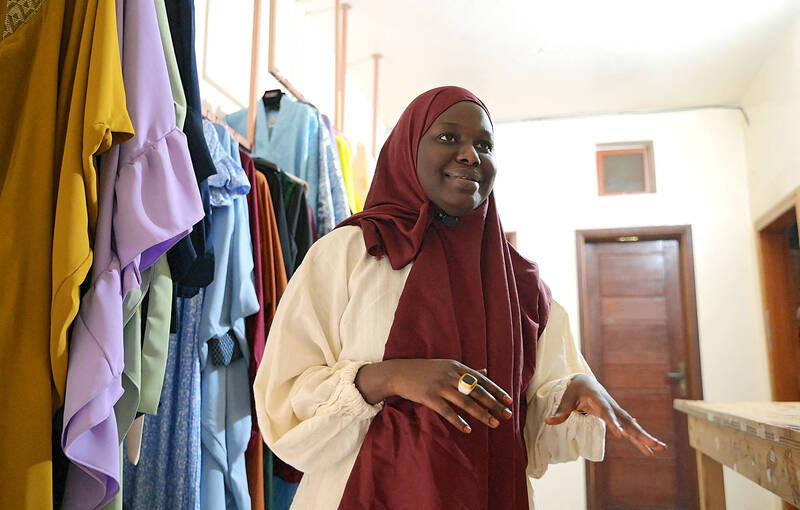Fatima Ba compliments a customer trying on one of her designs — a stylish silk dress in ocher with a gold motif made from start to finish in Senegal.
The founder of fashion label So Fatoo has made a name for herself in Senegal and beyond producing clothes that are locally made despite the country’s struggling textiles industry.
“Oh, it’s beautiful,” Ba enthused, as her customer emerged at the boutique in central Dakar wearing the V-necked creation with three-quarter length sleeves.

Photo: AFP
“Ten years ago, people didn’t wear so many locally made outfits,” she said.
Tailor Omar Niang, 51, who makes boubou robes fusing traditional styles and a modern twist, agreed that “Made in Senegal” clothing had become popular.
Locally produced clothes “are very trendy at the moment” and have helped drive his business significantly higher over the past few years, he said at a Dakar market.

Photo: AFP
Dresses, elegant traditional outfits for men, shirts, polo tops, sweaters — all are in vogue among a clientele generally from the upper middle class.
The popularity of locally produced wear has only grown since the arrival in power last year of Senegalese President Bassirou Diomaye Faye and Prime Minister Ousmane Sonko, fervent advocates of economic and cultural sovereignty.
In boubous made of west African embroidered bazin fabric, or custom-made with a round collar in a style known as an African suit, the two leaders never miss an opportunity to be seen publicly in locally made outfits.
Many Senegalese are following suit, opting to wear local labels at the office, when out and about or at official events.
However, producers face hurdles — taxes are high, and fabrics and clothes imported from abroad make for fierce competition.
Production costs in the west African country are high, while a lack of training hinders the industry and gaining access to finance is also difficult.
Just more than 11 percent of private companies are in the textile sector, which is the country’s second-biggest economic driver behind trade, according to the nation’s statistics from 2017.
However, the textiles industry also has the lowest economic performance, making just 1.2 percent of overall company turnover, a report by the National Statistics and Demography Agency showed.
The price of fabrics can be costly, and many people grumble that the quality is not up to scratch, prompting their preference for foreign products.
Prices at So Fatoo vary between 30,000 CFA francs (US$47) for a sweater and up to more than 300,000 CFA francs for a formal dress.
In a country where the average wage is US$85 a month, the clothes “are mostly aimed at a wealthy social class,” acknowledged Ba.
While it is easy to source fabrics for traditional outfits, the market is still in its infancy when it comes to manufacturing comfy wear such as jeans and T-shirts.
That is down to a lack of supply, but also weak technical ability among other things, Ba said.
Senegal is a cotton producer and was once known as an industrial hub for textiles, but the industry crumbled in the 1980s following the collapse of world cotton prices.
Aissa Dione a few years ago set up a machine-run production unit for fabrics, as well as a craft workshop.
However, on a recent visit, just two of the four machines, all old models, were fully operational, winding out lengths of fabric at the unit in a dusty outlying Dakar neighborhood, strewn with abandoned cars and rubbish.
About 30m of fabric are produced a day at the unit, but it is a drop in the ocean compared with what it could be turning out, said Dione, who has worked in textiles for 30 years.
“Senegal produces very good quality cotton, but is unable to transform its raw material. It’s paradoxical,” she said.
Industrialization is the “only solution for obtaining our sovereignty” in textiles, Dione said.
In a bid to breathe life into the sector, the new authorities relaunched in July last year an old textiles production factory in the central Kaolack region.
They also recently said they wanted in future to ban the import of second-hand clothes, a business which provides work for many Senegalese.
However, with thousands of tonnes of the much cheaper cast-offs coming into the country every year, the announcement has caused an uproar.

Leading Taiwanese bicycle brands Giant Manufacturing Co (巨大機械) and Merida Industry Co (美利達工業) on Sunday said that they have adopted measures to mitigate the impact of the tariff policies of US President Donald Trump’s administration. The US announced at the beginning of this month that it would impose a 20 percent tariff on imported goods made in Taiwan, effective on Thursday last week. The tariff would be added to other pre-existing most-favored-nation duties and industry-specific trade remedy levy, which would bring the overall tariff on Taiwan-made bicycles to between 25.5 percent and 31 percent. However, Giant did not seem too perturbed by the

Foxconn Technology Co (鴻準精密), a metal casing supplier owned by Hon Hai Precision Industry Co (鴻海精密), yesterday announced plans to invest US$1 billion in the US over the next decade as part of its business transformation strategy. The Apple Inc supplier said in a statement that its board approved the investment on Thursday, as part of a transformation strategy focused on precision mold development, smart manufacturing, robotics and advanced automation. The strategy would have a strong emphasis on artificial intelligence (AI), the company added. The company said it aims to build a flexible, intelligent production ecosystem to boost competitiveness and sustainability. Foxconn

TARIFF CONCERNS: Semiconductor suppliers are tempering expectations for the traditionally strong third quarter, citing US tariff uncertainty and a stronger NT dollar Several Taiwanese semiconductor suppliers are taking a cautious view of the third quarter — typically a peak season for the industry — citing uncertainty over US tariffs and the stronger New Taiwan dollar. Smartphone chip designer MediaTek Inc (聯發科技) said that customers accelerated orders in the first half of the year to avoid potential tariffs threatened by US President Donald Trump’s administration. As a result, it anticipates weaker-than-usual peak-season demand in the third quarter. The US tariff plan, announced on April 2, initially proposed a 32 percent duty on Taiwanese goods. Its implementation was postponed by 90 days to July 9, then

AI SERVER DEMAND: ‘Overall industry demand continues to outpace supply and we are expanding capacity to meet it,’ the company’s chief executive officer said Hon Hai Precision Industry Co (鴻海精密) yesterday reported that net profit last quarter rose 27 percent from the same quarter last year on the back of demand for cloud services and high-performance computing products. Net profit surged to NT$44.36 billion (US$1.48 billion) from NT$35.04 billion a year earlier. On a quarterly basis, net profit grew 5 percent from NT$42.1 billion. Earnings per share expanded to NT$3.19 from NT$2.53 a year earlier and NT$3.03 in the first quarter. However, a sharp appreciation of the New Taiwan dollar since early May has weighed on the company’s performance, Hon Hai chief financial officer David Huang (黃德才)